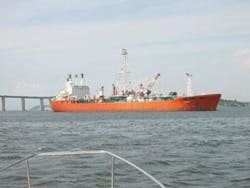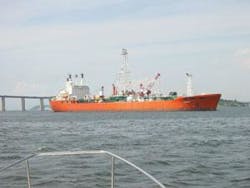Petrobras leads in deepwater EWT with DP FPSO
Gustavo Castro
Petrobras
Bruce Crager
Consultant
Operators rely on extended well testing (EWT) to provide data related to reservoir flow characteristics. Extended well tests and early production systems (EPS) help operators determine the commerciality of a field. They also help when developing design requirements of a long-term production system. Requirements can include production issues such as vertical permeability, oil/water relative permeability, water coning behavior, production performance of a long horizontal well, artificial lift, and oil processing.
EWTs last longer than drill stem tests, can have lower per day operating costs, and usually include containment as well as sale of the produced crude, unlike drill stem testing, which often only includes flaring. In the case of difficult or unknown reservoirs, such as those with heavy oil, an EWT also allows the operator to determine how to best process and transport the produced fluids.
Deepwater pioneers
Petrobras has performed EWTs for many fields and holds the world’s record for the EWT performed in the deepest water, a record set in 1999 using theSeillean FPSO in 6,077 ft of water in the Roncador field.
In fact, the operator has seen many firsts in its three decades of offshore production. Petrobras employed one of the first EPSs in the world on its first producing offshore field, Enchova, in the Campos basin off southeastern Brazil. Enchova was initially developed in 1977 using theSedco 135D, a converted semisubmersible drilling rig moored in 360 ft of water.
In the early days of offshore production in Brazil, particularly in the Campos basin, Petrobras used the EPS concept extensively. Since that first offshore field, the company has developed a large number of offshore projects around the world, including an installation in 2000 with the RO-8 well in the Roncador field in 6,194 ft. water depth.
One of the keys to a field’s successful development is understanding the production capacity before committing to full development. This is accomplished by performing appropriate well testing during drilling operations.
For fields where short-term drill stem testing is not adequate, Petrobras uses longer term EWTs and EPSs. Longer term tests provide a better understanding of the reservoir characteristics as well as information related to processing and transporting the produced fluids. Roncador, for example, will be produced using a large number of subsea wells producing to multiple floating production units.
The need for EWT and EPS systems led Petrobras to contract the FPSOSeillean from Reading and Bates Falcon in 1998. The initial contract was for four years, during which Petrobras confirmed the DP FPSO could operate as anticipated in Brazil’s offshore environment before committing to a longer term contract.
Modifications
Before contracting theSeillean, Petrobras requested two significant upgrades to the vessel that would allow it to operate in the Roncador field at water depths to 6,600 ft. The first was to keep the FPSO producing in the field by adding permanent facilities to allow produced fluids to be offloaded to DP shuttle tankers. The second was to incorporate an innovative drill pipe riser system because the original production riser was only designed for 660 ft water depth and could not be extended much further.
Petrobras and FMC jointly developed the drill pipe riser for 6,600 ft water depth. The drillpipe riser can accommodate up to two subsea wells though the 6 5/8-in. monobore riser. A subsea christmas tree, developed by CBV, a Brazilian subsidiary of FMC, sits at the bottom of the riser. The tree has a manifold mounted to it that can accept production through a flowline from an adjacent subsea tree.
These two modifications were critical in allowing theSeillean to fulfill Petrobras’ EWT needs. The ability to remain connected to the well while processing, storing, and offloading oil meant the FPSO could accomplish long-term flow tests of the reservoir. The continuity of production also improved economics of each EWT.
Petrobras first used theSeillean to produce a single well, RJS-436, in the Roncador field in what was a world record water depth of 6,077 ft. The FPSO produced RJS-436 from January 1999 until January 2001, with total production of 12 MMbbl. The Seilleanthen moved to nearby well 9-RO-02 in 5,940 ft. water depth and produced 6.5 MMbbl from March 2001 to June 2002.
Petrobras then decided to use theSeilleanto perform an EWT at the heavy oil Jubarte field. In June 2002, the FPSO moved to a sheltered location in Brazil so it could be upgraded to handle heavy crude. This upgrade was preformed by the new owner, Frontier Drilling do Brazil, which bought the vessel in December 2001. The processing system was modified to handle up to 22,500 b/d of API 17° crude. The primary upgrades were to add a much larger heat exchanger on deck to accommodate the need for more heat to process the heavy crude along with a large boiler to produce steam for process heating. Other modifications included pipe modifications to facilitate cargo heating in an emergency situation, a new meter station, and a variable speed drive to operate an electrical submersible pump in the riser or well bore.
TheSeillean moved to the Jubarte field in September 2002 and started production at well ESS-100 in 4,373 ft. The production riser was modified to include an electrical cable to feed a submersible pump installed just above the single subsea tree to boost production. Produced fluids are separated from gas, and the processed gas is used to generate energy and power for the FPSO. Excess gas can be flared through the Seillean’s vertical flare on the bow, which can handle up to 14 MMcf/d.
Because Jubarte oil has a low gas-to-oil ration, very little excess gas needs to be flared. Most of the gas is consumed for power production by the three gas turbines and to produce steam for process heating. Produced fluids are placed in theSeillean’s center tanks.
On average, offloading occurs every 10 days to a 285,000-bbl-capacity DP shuttle tanker. During offloading, a single hawser connects the bow of theSeillean to the shuttle tanker, but the hawser is kept slack because the vessels are kept approximately 500 ft apart and each continues to operate in DP mode. Offloading takes place through a 12-in. offloading hose. When offloading begins, the Seillean’s tanks are stripped of water, which is sent to a dedicated tank(s) on the shuttle tanker. Next the produced oil is transferred to separate tanks on the shuttle tanker. The shuttle tanker offloads both the water and oil at the refinery.
The long-term Jubarte test provided valuable reservoir information and has allowed Petrobras to design and optimize the full-field production facilities. The maximum production rate at Jubarte was 22,000 b/d from one well. This EWT resulted in the successful test of an open hole gravel-pack completion with over 3,300 ft of horizontal section.
The ESP has operated successfully, and the temperature loss between the subsea tree and the production header was much lower than predicted. During static periods, the oil did not solidify. Continuous acquisition of downhole pressure and temperature allowed a match of the 3D three-phase reservoir simulator with the produced reservoir history.
The successful use of theSeillean for this EWT resulted in gathering data so that Jubarte could be declared commercial in December 2002. Continued production with the Seillean at Jubarte has resulted in more long-term production data and has allowed Petrobras to profit from Jubarte production while preparing to relocate the Seillean to the Golfinho field, where the DP FPSO will work for at least one year.
EWT plans
Petrobras plans to continue using theSeilleanfor future EWT activities, and in May 2005, signed a new four-year contract for theSeilleanwith options for two more years. The company has other fields requiring evaluation and is considering leasing a second DP FPSO. This initiative, called PIPA II, is expected to result in a five-year contract for a DP FPSO with storage capacity of at least 300,000 bbl of produced fluid. The FPSO will be able to process up to 30,000 b/d and operate in 8,250 ft.
Petrobras continues to benefit from performing EWT operations as part of its strategy to aggressively find and develop its deepwater fields. The company will continue to use theSeillean FPSO as an important component of this development strategy. •
Gustavo Castro has over 18 years of experience with Petrobras in the oil and gas industry eight years of experience in naval construction, working in shipyards in Brazil. Castro earned Naval Architecture degree in 1978 and an M.Sc. in Ocean Engineering in 2003. He is manager of Petrobras’ E&P structural and naval technology department. [email protected]
Bruce Crager has over 30 years’ experience in the oil and gas industry and is currently consulting to Petrobras America as early production system project manager. Previous positions include president of ABB Offshore Systems Inc., senior vice president of Oceaneering International, and positions within Vetco, Seaflo Systems, and what is now Transocean. [email protected]
Seillean history
TheSeillean is dynamically positioned and has a derrick to run and retrieve a rigid production riser. These features simplify connect and disconnect operationsand allow the FPSO to weathervane around the production riser, which passes through the vessel’s centrally located moonpool. A surface tree on the rigid riser connects to flexible jumpers in the moonpool, and a control umbilical runs with the riser to control the subsea christmas tree at the lower end of the riser and acts as an emergency disconnect just above the subsea tree.
TheSeillean can store 300,000 bbl of produced fluids in the center tanks. Its original process rate was 12,000 b/d. All of the FPSO’s process equipment is in the hull. Outer ballast tanks provide double hull capability and allow the vessel to remain at a constant draft because the vessel can be ballasted and de-ballasted to offset the amount of production. This constant draft feature allows for constant tension of the production riser and keeps the surface tree at the same height in the moonpool.
BP developed theSeillean for North Sea marginal fields. The word Seillean is Gaelic for honey bee and was chosen because the basic operational concept was for the vessel to move from well to well collecting oil like a bee goes from flower to flower collecting pollen.
Originally, designers intended for theSeillean to produce from a well until the vessel reached its full storage capacity, at which point it would disconnect and take the produced crude to a nearby offloading point. The vessel was designed to be all encompassing and did not need to offload to shuttle tankers. BP called this concept the single well oil production system (SWOPS).
The SWOPS concept was driven by BP’s desire to use the vessel at different water depths, a capability that was realized by running and retrieving the rigid production riser using the derrick over the moonpool.
TheSeillean was delivered in 1989 and produced from the Cyrus and Doran fields in the North Sea until 1997. In 1998, R&B Falcon, which bought the Seillean from BP the previous year, proposed to Petrobras that the vessel be used as a pilot system in the giant Roncador field that had recently been discovered offshore Brazil. Because the operation in Roncador would require significant modifications to the FPSO, Petrobras and R&B Falcon agreed to a longer term contract to better compensate the drilling contractor for investment in the vessel.

